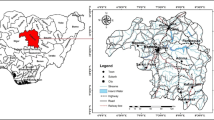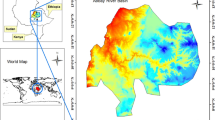Abstract
The Beles River Basin is one of the major river basins of the upper Blue Nile Basin. This paper deals with the demarcation of favorable groundwater potential zones in the Beles River Basin, Ethiopia, using geographic information system. The various determinant factors of groundwater potential (slope, drainage density, stream power index, fault density, hydrological soil groups, soil texture, saturated hydraulic conductivity, available water capacity, soil bulk density, soil organic carbon, soil depth, soil erodibility, and soil type) were analyzed based and reclassified according to their potential of infiltration and groundwater potential. All the determinant factors were overlaid using “Weighted index overlay analysis” tool in geographic information system domain. The final groundwater prospectus map shows the areas of very low, low, moderate, and high groundwater potential areas. 19.34% of total area was found to have high groundwater potential. While as 41.82%, 32.06%, and 6.79% of the total area represent moderate, low, and very low groundwater potential areas.







Similar content being viewed by others
References
Alemayehu T (2006) Groundwater occurrence in Ethiopia. Addis Ababa University, Addis Ababa 107 pp
Dar MA, Sankar K, Dar IA (2010) Groundwater prospects evaluation-based on hydrogeomorphological mapping: a case study in Kancheepuram district, Tamil Nadu. J Indian Soc Remote Sens 38(2):333–343
Dar IA, Sankar K, Dar MA (2010a) Remote sensing technology and geographic information system modeling: an integrated approach towards the mapping of groundwater potential zones in Hardrock terrain, Mamundiyar basin. J Hydrol 394(3):285–295
Dar IA, Sankar K, Dar MA (2010b) Deciphering groundwater potential zones in hard rock terrain using geospatial technology. Environ Monit Assess 173(1):597–610
FAO (2005) Aquastat, FAO water report 29, 2005. http://www.fao.org/nr/water/aquastat/countries/ghana/index.stm
Fashae OA, Tijani MN, Talabi AO, Adedeji OI (2014) Delineation of groundwater potential zones in the crystalline basement terrain of SW-Nigeria: an integrated GIS and remote sensing approach. Appl Water Sci 4(1):19–38
Fetter CW (1994) Applied hydrogeology, 3rd edn. Prentice Hall, Upper Saddle River, p 691
Gebre T, Ahmad I, Dar MA, Gadissa E, Teka AH, Tolosa AT, Brhane ES (2018) Mapping of groundwater potential zones using remote sensing and geographic information system: a case study of parts of Tigray, Ethiopia. Environ Geosci 25(4):133–140
Gebrie T, Gadissa E, Ahmad I, Dar MA, Teka AH, Tolosa AT, Brhane ES, Fenta A (2018) Groundwater resources evaluation using geospatial technology. Environ Geosci 25(1):25–35
Hoffmann J (2005) The future of satellite remote sensing in hydrogeology. Hydrogeol J 13(1):247–250
Jaiswal RK, Mukherjee S, Krishnamurthy J, Saxena R (2003) Role of remote sensing and GIS techniques for generation of groundwater prospect zone towards rural development: an approach. Int J Remote Sens 24(5):993–1008
Machiwal D, Jha MK, Singh PK, Mahnot SC, Gupta A (2004) Planning and design of cost-effective water harvesting structures for efficient utilization of scarce water resources in semiarid regions of Rajasthan, India. Water Resour Manag 18(3):219–235
Masiyandima M, Giordano M (2007) Sub-Saharan Africa: opportunistic exploitation. In: Giordano M, Villholth K (eds) The agricultural groundwater revolution: opportunities and threats to development. CABI, Wallingford, pp 79–99
Natural Resources Conservation Service Soil Survey Staff (1996) National Soil Survey handbook. Title 430-VI. U.S. Government Printing office, Washington, DC
Roscoe MO (1990) Handbook of groundwater development. Wiley, New York, p 512
Tweed SO, Leblanc M, Webb JA, Lubczynski MW (2007) Remote sensing and GIS for mapping groundwater recharge and discharge areas in salinity prone catchments, southeastern Australia. Hydrogeol J 15(1):75–96
Author information
Authors and Affiliations
Corresponding author
Rights and permissions
About this article
Cite this article
Ahmad, I., Dar, M.A., Andualem, T.G. et al. Groundwater development using geographic information system. Appl Geomat 12, 73–82 (2020). https://doi.org/10.1007/s12518-019-00283-6
Received:
Accepted:
Published:
Issue Date:
DOI: https://doi.org/10.1007/s12518-019-00283-6




